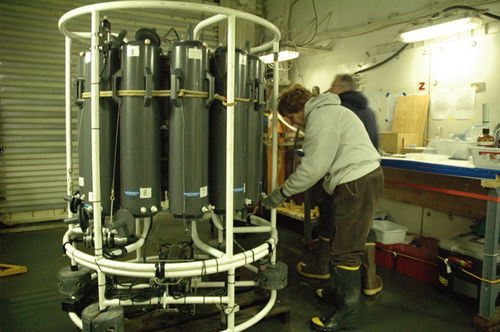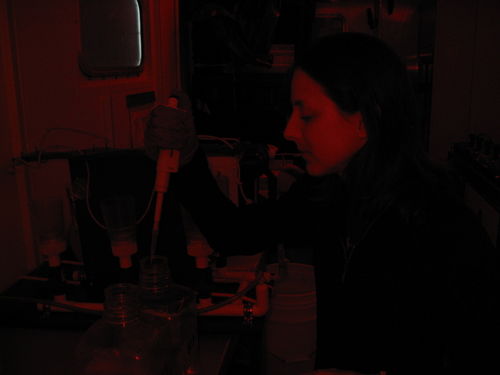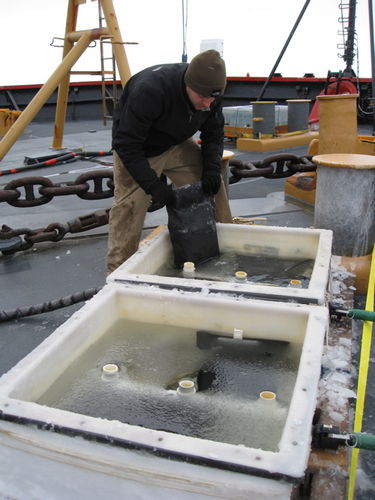Lat: 59 52.757N Long: 173 31.007W
What's a CTD? And for that matter, what's the difference between a CTD STD and a CTD PROD? Nearly everything that happens, scientifically speaking, on the Healy revolves around the deployment of this mysterious CTD. For the first few days, I pretended to know what it looked like. Then, spotted this strange creature in the starboard aft deck. I investigated.
 Nancy and Dave Kachel are oceanograpers in Washington. They are collecting samples from the CTD to test for seven different water properties; including salt, nutrients, oxygen, carbon, chlorophyll.
Nancy and Dave Kachel are oceanograpers in Washington. They are collecting samples from the CTD to test for seven different water properties; including salt, nutrients, oxygen, carbon, chlorophyll.
The CTD, (Conductivity, Temperature and Depth) is the instrument that collects ocean water samples. A crane on the starboard side of the ship carefully lowers this 12-cylindered machine into the water. Today, it reached the bottom at 81 meters. (Pop quiz guys: How many feet is that if is each meter is about 3 feet?) Once at the bottom, one of the bottles snaps shut catching seawater from the lowest point. As the CTD travels up the water column towards the surface, other bottles close capturing samples from various depths. Scientists can then test the different levels for algae, plankton, oxygen and various nutrients in the water. They can compare what changes as you move away from the light and towards the dark depths.
CTD STD means that the CTD is deployed, or sent over the side, for a standard sampling. This is done each time the ship stops at a different location. CTD PROD implies that the samples will be tested for productivity or what's going on at different levels of scientists choosing. They make their choices depending upon the availability of light at a given site.
This morning the samples came on deck at 0830. I was there with the production team to collect the goods. First, we filled 18 bottles, carefully noting which cylinder we had taken them from. Then we "spiked" the samples with, ammonia, nitrate and carbon. Ammonia was my job!
 Adding the ammonia takes a steady hand and a pipetter in the red room. Working in the near- dark is important for limiting production to the natural environment.
Adding the ammonia takes a steady hand and a pipetter in the red room. Working in the near- dark is important for limiting production to the natural environment.
Now the samples were ready to "incubate". The term incubator usually conjures up images of fuzzy chicks and babies under warm lights. Not so with Arctic phytoplankton. These incubations take place on the windy bow in water that has a nasty habit of freezing over.
After scooping out the chunks of ice that had accumulated in the incubator, we lowered the samples into the chilly water and left them to incubate or change over time. The idea is that the organisms in these samples can stay in water that is as close to their natural habitat as possible but their activity can be monitored as if it were happening in a lab.
 Kris Swenson lowers bottles of seawater samples into his incubator on the bow. He will be watching for changes related to the phytoplankton over time.
Kris Swenson lowers bottles of seawater samples into his incubator on the bow. He will be watching for changes related to the phytoplankton over time.
This team of scientists will notice how much of various nutrients the plankton trapped inside will take up over 4, 6, 8 or 24 hours. They will record these changes to better understand what kinds of processes are happening down below the ice in the freezing water of the Bering Sea.
From the windy bow to the cold room... The cold rooms on the boat are large walk-in freezers where people can do work in conditions that are similar to the outside. Organisms and water conditions can be studied at close to their normal temperatures while the scientists have access to their tools and the safety of the indoors. Stay tuned for my adventures chasing copepods under the microscope... I'm off to thaw my fingers out!

